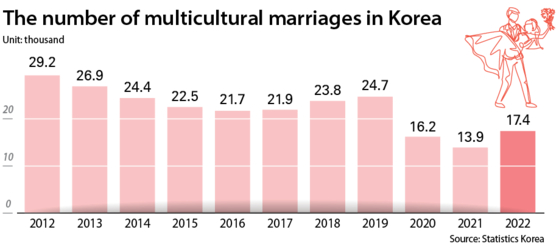Potential solution to world's lowest birthrate? Multicultural marriages
Published: 16 Dec. 2023, 06:00
Updated: 18 Dec. 2023, 16:24
-

- JIN MIN-JI
- jin.minji@joongang.co.kr
![Pictures of children from multicultural families at Hapseong Elementary School in Gimhae, South Gyeongsang. [SONG BONG-GEUN]](https://koreajoongangdaily.joins.com/data/photo/2023/12/18/089e74f6-653d-4bf9-bed1-c8cdab4c123e.jpg)
Pictures of children from multicultural families at Hapseong Elementary School in Gimhae, South Gyeongsang. [SONG BONG-GEUN]
Multicultural marriage between Koreans and foreign spouses jumped at the fastest pace in 2022, raising hopes for its potential contribution to helping Korea overcome the lowest fertility rate among members of the Organisation for Economic Cooperation and Development (OECD).
Nevertheless, their challenges in adapting to life in Korea persist, underscoring calls for the implementation of more sophisticated training programs to assist multicultural families in their adjustment.
The number of multicultural marriages last year jumped 25.1 percent from a year earlier to reach 17,428, according to Statistics Korea data from late November. Among them, 66.8 percent were foreign wives, 20 percent were foreign husbands and 13.2 percent were naturalized Koreans.
“More Koreans are shifting their lifestyles to non-marriage or late marriage amid low economic growth,” said Jeon Young-soo, a professor who teaches global social economy at the Hanyang University Graduate School of International Studies.
“The imbalance of supply and demand along with the ‘Korean Dream’ abroad has created an environment for multicultural marriage to grow, a trend that will inevitably expand.”
Vietnam accounted for the largest proportion of foreign and naturalized Korean wives with 23 percent, up a whopping 9.4 percentage points on-year. It was followed by China with 17.8 percent, down 6.1 percentage points, and Thailand with 11.1 percent, down 0.3 percentage points over the same period.
“A jump in Vietnamese spouses is largely due to economic reasons,” said Prof. Chung Yong-kyo, who teaches at the College of Social Science at Yeungnam University. “China has shown rapid growth. But from the perspective of the Vietnamese, Korea remains a very attractive country considering the income gap between the two nations.”
University graduates in Vietnam receive around 500,000 won ($390) in monthly salary, roughly eight to 10 times lower than the salary received by employees at Korean conglomerates, he added.
“Aggressive expansion of Korean firms into Vietnam has also raised the familiarity of Korean food and content in the country, increasing affinity toward Korea,” Chung added.
GS Retail, an operator of GS25 convenience stores, and hamburger franchise Lotteria are some of the Korean companies that operate in Vietnam.

As for husbands, the largest nationality represented was the United States at 8 percent, followed by China with 6.5 percent and Vietnam with 3.4 percent.
The number of births to multicultural couples fell for two consecutive years, plunging 12.5 percent last year from a year earlier to 12,526, attributed to fewer international marriages over the past couple of years.
Despite the weak recent records, multicultural marriage is seen as a potential solution that is expected to contribute to overcoming Korea's low fertility rate of 0.78 last year, which is even lower than the 0.81 the previous year, according to Statistics Korea data. The slump has aggravated in recent months, falling to 0.70 in the third quarter.
Countries need fertility rates of around 2.1 to maintain the population, according to demographic experts.
Korea’s economic growth could plummet below 0 percent by 2050 if the country fails to properly address the fertility issue, according to the Bank of Korea in a report earlier this month.
“The increased number of marriages translates into an environment with a higher chance of an increased birthrate,” said Jeon. “Since a lot of multicultural families live in the suburban areas, living costs are comparatively lower than in cities, making the cost of raising a child less financially burdensome.”
The largest portion of multicultural marriages was observed in Jeju Island, comprising 10.8 percent, followed by South Chungcheong at 10.6 percent and South Jeolla at 10.4 percent — all outside the greater Seoul areas.
However, the government should develop proper training programs and support measures for multicultural families, who often find it challenging to adjust to their new environment.
Their struggles are reflected in the rate of sadness and suicide by adolescents born in families with different cultural backgrounds, according to “Suicide risk among racial minority students in a monoethnic country,” published by Park Myung-bae, a professor who teaches at the Department of Health and Welfare at Pai Chai University, in November.
In regards to experiencing extreme sadness and desperation, the group with both parents born outside Korea had the highest rate of 37.1 percent, while the rate for their suicidal ideation was 24.7 percent. They were followed by the father-only, non-intercultural families and mother-only groups. The study was conducted on some 587,000 participants from 2011 to 2020.
The study attributed their higher level of suffering to financial reasons, the state of being a minority, cultural confusion, difficulties communicating with foreign parents and conflicts with friends. The language barrier, weak scholastic performance and discrimination were cited as factors that made their time at school challenging.
“The current findings demonstrate that the intercultural families (ICFs) group is more vulnerable to suicide risk than the non-ICF group,” according to the report. “Thus, adolescents from ICFs are a high-risk group for suicide and should be a top priority for intervention.”
“For multicultural families to give birth and raise a child in Korea, they need a sophisticated training program from reputable institutions to help them adjust to Korea,” Chung said. “They also need well-educated foreigners that can help shape the [government] support measures and education programs for multicultural families.”
BY JIN MIN-JI [jin.minji@joongang.co.kr]










with the Korea JoongAng Daily
To write comments, please log in to one of the accounts.
Standards Board Policy (0/250자)